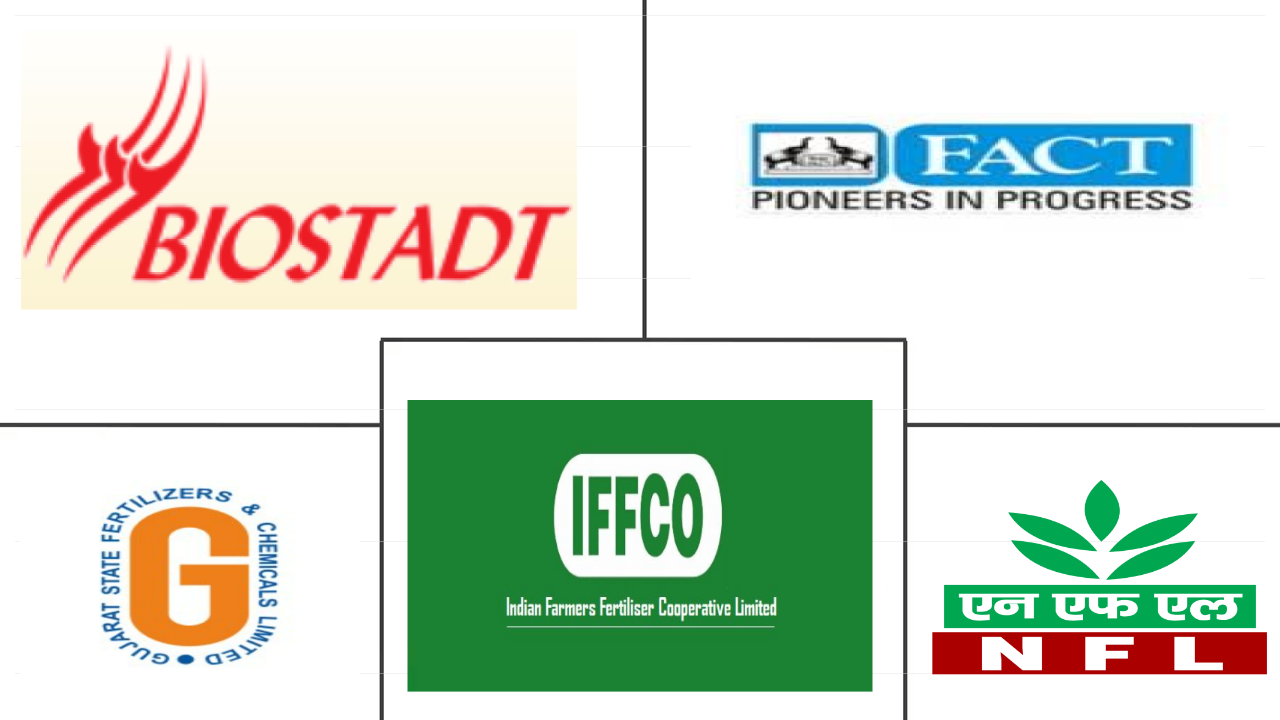Market Size of india biofertilizer Industry
| Icons | Lable | Value |
|---|---|---|
|
|
Study Period | 2017 - 2029 |
|
|
Market Size (2024) | USD 138 Million |
|
|
Market Size (2029) | USD 213.9 Million |
|
|
Largest Share by Form | Mycorrhiza |
|
|
CAGR (2024 - 2029) | 9.15 % |
|
|
Fastest Growing by Form | Rhizobium |
|
|
Market Concentration | Low |
Major Players |
||

|
||
|
*Disclaimer: Major Players sorted in no particular order |
India Biofertilizer Market Analysis
The India Biofertilizer Market size is estimated at 138 million USD in 2024, and is expected to reach 213.9 million USD by 2029, growing at a CAGR of 9.15% during the forecast period (2024-2029).
138 Million
Market Size in 2024 (USD)
213.9 Million
Market Size in 2029 (USD)
6.80 %
CAGR (2016-2023)
9.15 %
CAGR (2024-2029)
Largest by Form
49.17 %
value share, Mycorrhiza, 2023
The mycorrhizal association helps boost phosphorus, other nutrients, and water absorption from the soil, supporting plant growth and development and increasing yield.
Fastest by Form
11.23 %
Projected CAGR, Rhizobium, 2024-2029
Rhizobium's symbiotic association with some species of legume crops can fix 200-300 kilograms of nitrogen per year and can reduce dependence on chemical nitrogen fertilizers.
Largest by Crop Type
88.48 %
value share, Row Crops, 2023
The dominance of row crops is mainly due to their large organic cultivation areain the country, which accounted for about 59.8% of the total organic crop area in 2022.
Fastest by Crop Type
9.18 %
Projected CAGR, Row Crops, 2024-2029
There is an increasing trend in the overall organic row crop area in the country, which has increased from 409.2 thousand hectares in 2017 to 424.4 thousand hectares in 2021.
Leading Market Player
1.86 %
market share, Indian Farmers Fertiliser Cooperative Limited, 2022

The biofertilizer products offered by the company are compatible with all types of crops like cereals, horticultural crops and cash crops sold under the IFFCO brand name
- Biofertilizers are organic substances with living microorganisms that promote plant growth. The Indian biofertilizer market value increased by about 11.0% between 2017 to 2021, which can be attributed to various reasons like the increasing awareness among farmers, the increasing overall registered organic farms in India, and a shift in demand for organically or sustainably grown commodities. India ranks fifth in terms of world organic agriculture land and first in terms of the total number of producers as of 2021.
- Mycorrhizal-based biofertilizers dominated the market, which was valued at USD 57.5 million in 2022. This is mainly due to the mycorrhizal association holding the ability to boost phosphorus, other nutrients, and water absorption from the soil, supporting plant growth and development and increasing yield. It also helps the plant fight against adverse soil conditions. However, Rhizobium and Azospirillum-based biofertilizer market values are anticipated to grow at faster rates compared to other biofertilizers.
- The consumption of biofertilizers is dominant in row crops, and it accounted for about 88.5% of the market value in 2022. The dominance of row crops is mainly due to their large cultivation area in the country, which accounted for about 59.8% of the total organic crop area in the same year.
- There is a huge demand for organic products both in domestic and international markets. The overuse of chemical fertilizers is one of the major challenges in the country. The Indian government is promoting sustainable or organic cultivation practices through various schemes or programs by providing incentives for biofertilizers, which would drive the market between 2023 and 2029.
India Biofertilizer Industry Segmentation
Azospirillum, Azotobacter, Mycorrhiza, Phosphate Solubilizing Bacteria, Rhizobium are covered as segments by Form. Cash Crops, Horticultural Crops, Row Crops are covered as segments by Crop Type.
- Biofertilizers are organic substances with living microorganisms that promote plant growth. The Indian biofertilizer market value increased by about 11.0% between 2017 to 2021, which can be attributed to various reasons like the increasing awareness among farmers, the increasing overall registered organic farms in India, and a shift in demand for organically or sustainably grown commodities. India ranks fifth in terms of world organic agriculture land and first in terms of the total number of producers as of 2021.
- Mycorrhizal-based biofertilizers dominated the market, which was valued at USD 57.5 million in 2022. This is mainly due to the mycorrhizal association holding the ability to boost phosphorus, other nutrients, and water absorption from the soil, supporting plant growth and development and increasing yield. It also helps the plant fight against adverse soil conditions. However, Rhizobium and Azospirillum-based biofertilizer market values are anticipated to grow at faster rates compared to other biofertilizers.
- The consumption of biofertilizers is dominant in row crops, and it accounted for about 88.5% of the market value in 2022. The dominance of row crops is mainly due to their large cultivation area in the country, which accounted for about 59.8% of the total organic crop area in the same year.
- There is a huge demand for organic products both in domestic and international markets. The overuse of chemical fertilizers is one of the major challenges in the country. The Indian government is promoting sustainable or organic cultivation practices through various schemes or programs by providing incentives for biofertilizers, which would drive the market between 2023 and 2029.
| Form | |
| Azospirillum | |
| Azotobacter | |
| Mycorrhiza | |
| Phosphate Solubilizing Bacteria | |
| Rhizobium | |
| Other Biofertilizers |
| Crop Type | |
| Cash Crops | |
| Horticultural Crops | |
| Row Crops |
India Biofertilizer Market Size Summary
The India biofertilizer market is experiencing significant growth, driven by increasing awareness among farmers and a shift towards organically and sustainably grown commodities. As India ranks high in organic agriculture, both in terms of land and number of producers, the demand for biofertilizers is on the rise. Mycorrhizal-based biofertilizers currently dominate the market due to their ability to enhance nutrient and water absorption, supporting plant growth and yield. The consumption of biofertilizers is primarily seen in row crops, which occupy a substantial portion of the organic crop area in the country. The Indian government's initiatives to promote sustainable farming practices and provide incentives for biofertilizers are expected to further boost market growth in the coming years.
Despite the challenges posed by the overuse of chemical fertilizers, the Indian biofertilizer market is poised for expansion, supported by the growing demand for organic products both domestically and internationally. The market is characterized by a fragmented landscape, with major players like Biostadt India Limited and Fertilizers and Chemicals Travancore Limited leading the charge. The organic food and beverage sector in India is also witnessing a promising trajectory, with increasing consumer awareness and demand for organic products. However, the price premium associated with organic products remains a barrier for lower-income consumers. Overall, the market is expected to grow steadily, driven by government support and changing consumer preferences towards organic and sustainable options.
India Biofertilizer Market Size - Table of Contents
-
1. MARKET SEGMENTATION (includes market size in Value in USD and Volume, Forecasts up to 2029 and analysis of growth prospects)
-
1.1 Form
-
1.1.1 Azospirillum
-
1.1.2 Azotobacter
-
1.1.3 Mycorrhiza
-
1.1.4 Phosphate Solubilizing Bacteria
-
1.1.5 Rhizobium
-
1.1.6 Other Biofertilizers
-
-
1.2 Crop Type
-
1.2.1 Cash Crops
-
1.2.2 Horticultural Crops
-
1.2.3 Row Crops
-
-
India Biofertilizer Market Size FAQs
How big is the India Biofertilizer Market?
The India Biofertilizer Market size is expected to reach USD 138.04 million in 2024 and grow at a CAGR of 9.15% to reach USD 213.86 million by 2029.
What is the current India Biofertilizer Market size?
In 2024, the India Biofertilizer Market size is expected to reach USD 138.04 million.

